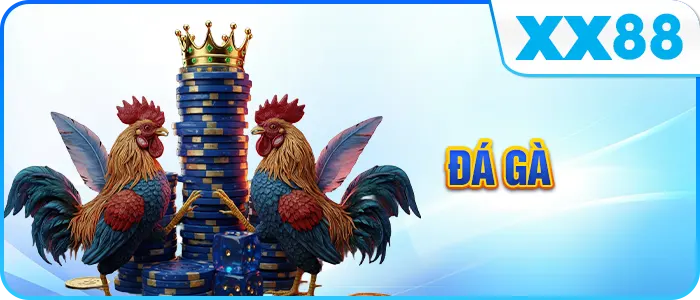

Hãy tham gia XX88 ngay để trải nghiệm thế giới game đỉnh cao hàng đầu
XX88 - Truy Cập Link Trang Chủ Mới Nhất +888k
XX88 – siêu nền tảng cá cược trực tuyến đẳng cấp, nơi hội tụ đầy đủ các trò chơi hấp dẫn nhất hiện nay: cá cược thể thao, casino live, bắn cá đổi thưởng, lô đề, slot game và hàng loạt tiện ích độc quyền. Với công nghệ bảo mật tiên tiến, giao diện tối ưu cho mọi thiết bị và dịch vụ nạp rút siêu tốc 24/7
XX88 không chỉ mang đến trải nghiệm giải trí đỉnh cao mà còn đảm bảo an toàn tuyệt đối cho người chơi. Tham gia ngay https://vasa.eu.com/ hôm nay để nhận khuyến mãi khủng và tận hưởng thế giới cá cược chuẩn quốc tế!
Tổng hợp link truy cập chính thức XX88
Để đảm bảo tham gia cá cược an toàn và nhận đầy đủ ưu đãi hấp dẫn từ nhà cái XX88, người chơi cần truy cập chính xác các đường link chính thức của XX88. Hiện nay, nhiều trang web giả mạo thương hiệu XX88 xuất hiện ngày càng nhiều, gây ra nguy cơ mất thông tin cá nhân, lỗi nạp rút tiền và mất quyền lợi khi chơi.
Tình trạng này không chỉ ảnh hưởng nghiêm trọng đến trải nghiệm người chơi mà còn làm suy giảm uy tín vững chắc mà XX88 đã xây dựng. Vì vậy, để bảo vệ quyền lợi cá nhân và có trải nghiệm cá cược mượt mà, hãy luôn sử dụng các link truy cập chính chủ, an toàn được tổng hợp bên dưới

| STT | Link Truy Cập | Tình Trạng | Phần Thưởng Đăng Nhập | Ưu Đãi Người Mới | Bảo Mật SSL | Đánh Giá Người Dùng |
|---|---|---|---|---|---|---|
| 1 | Link XX88 1 | Hoạt động | 150K VNĐ | +60% tiền nạp đầu | ✅ Có | ⭐ 4.8/5 |
| 2 | Link XX88 2 | Hoạt động | Vòng quay may mắn | Tặng 25K chơi thử | ✅ Có | ⭐ 4.7/5 |
| 3 | Link XX88 3 | Tạm ngưng | 70K VNĐ | Miễn phí nạp lần đầu | ✅ Có | ⭐ 4.3/5 |
| 4 | Link XX88 4 | Hoạt động | Giftcode 50K | Nạp 200K tặng 150K | ✅ Có | ⭐ 4.9/5 |
| 5 | Link XX88 5 | Bảo trì | — | — | ✅ Có | ⭐ 4.0/5 |
| 6 | Link XX88 6 | Hoạt động | 120 vòng quay miễn phí | Thưởng 25% nạp đầu | ✅ Có | ⭐ 4.6/5 |
-
Luôn đảm bảo truy cập đúng đường link được nhà cái XX88 cung cấp để tránh các trang giả mạo, nguy cơ mất thông tin và tiền bạc.
-
Kiểm tra trạng thái hoạt động của link trước khi đăng nhập để tránh gián đoạn khi chơi.
-
Ưu tiên sử dụng các link có bảo mật SSL để bảo vệ dữ liệu cá nhân và giao dịch an toàn.
-
Cập nhật thường xuyên các link mới nhất được chúng tôi cung cấp để đảm bảo trải nghiệm mượt mà và hưởng trọn ưu đãi.
-
Nếu gặp sự cố khi truy cập hoặc nạp rút, hãy liên hệ ngay bộ phận hỗ trợ khách hàng chính thức của XX88 để được trợ giúp nhanh chóng.
Tổng quan về thương hiệu cá cược trực tuyến xx88
Để trở thành một trong những thương hiệu cá cược trực tuyến được tin tưởng hàng đầu hiện nay, XX88 đã trải qua một chặng đường phát triển đầy nỗ lực và đổi mới không ngừng. Hãy cùng điểm lại hành trình hình thành và những dấu mốc quan trọng đã làm nên tên tuổi của nhà cái này
quá trình hình thành và phát triển của nhà cái xx88
Ra đời từ những năm 2020 , XX88 đã trải qua quá trình hình thành và phát triển mạnh mẽ bởi sự điều hành của tổng bộ liên minh KJC có trục sở chính tại Manila – philippines . Được cấp pháp hoạt động hợp pháp bởi tổ chức PAGCOR , đảm bảo mọi hoạt động cá cược , giao dịch , và vận hành đều phải được công khai minh bạch và an tàn tuyện đối.
Sân chơi XX88 đã vươn mình thành điểm giải trí lớn của thị trường châu Á sở hũ hơn 10.000.000 thành viên cùng với đội ngũ nhân viên có thể được cho là toàn diện đáp ứng đủ nhu cầu mong muốn của người chơi.

tầm nhìn và sứ mệnh của thương hệ xx88
Với sứ mệnh mang đến một sân chơi cá cược minh bạch, an toàn và đẳng cấp quốc tế, XX88 luôn lấy người dùng làm trung tâm trong mọi chiến lược phát triển. Tầm nhìn dài hạn của thương hiệu là trở thành hệ sinh thái giải trí số hàng đầu châu Á, nơi kết hợp giữa công nghệ hiện đại, dịch vụ chuyên nghiệp và trải nghiệm cá cược toàn diện cho mọi đối tượng người chơi.
Những giá trị tạo nên ưu thế nổi trội của XX88
kho game đa dạng của sân chơi xx88


Cá cược thể thao ở tầm chuyên nghiệp, nơi người chơi bản lĩnh sẵn sàng đón đầu mọi kèo đấu
Bước vào thế giới cá cược thể thao đẳng cấp của sân chơi XX88, nơi mỗi trận đấu là thử thách đòi hỏi chiến lược và sự nhạy bén. Người chơi bản lĩnh không chỉ dự đoán chính xác mà còn làm chủ cuộc chơi, sẵn sàng đối mặt mọi biến động kèo để giành chiến thắng thuyết phục.

Game bài hấp dẫn kết hợp yếu tố tính toán, mang lại lợi thế lớn cho người chơi biết nắm bắt thời cơ
Thể loại game bài hiện đại không chỉ mang tính giải trí mà còn đòi hỏi chiến lược rõ ràng. Người chơi có khả năng phân tích và đưa ra quyết định đúng lúc sẽ dễ dàng vươn lên dẫn trước. Mỗi ván bài là cơ hội thể hiện bản lĩnh và rinh phần thưởng hấp dẫn về tay.

Tham gia bắn cá giải trí cực đã, nhận thưởng nhanh chóng chỉ sau vài lượt bắn chuẩn
Đắm chìm trong không gian bắn cá sinh động với đồ họa mãn nhãn và hiệu ứng cực cuốn. Mỗi pha ngắm bắn chuẩn xác đều mở ra cơ hội nhận thưởng siêu tốc. Không chỉ giải trí đỉnh cao, XX88 còn mang đến trải nghiệm săn thưởng đầy kịch tính chỉ trong vài thao tác đơn giản.

Khám phá vòng quay nổ hũ đầy kịch tính, chinh phục giải jackpot khủng mỗi ngày
Hòa mình vào không gian nổ hũ đỉnh cao, nơi từng vòng quay đều chứa đựng kịch tính và cơ hội bứt phá tài chính. Jackpot khủng đang chờ người chơi may mắn và bản lĩnh nhất. Chỉ cần một lần quay chuẩn, bạn hoàn toàn có thể đổi đời trong tích tắc!

Phân tích xổ số chuyên sâu giúp bạn nhanh chóng giành được giải thưởng lớn.
Phân tích xổ số kỹ lưỡng là bí quyết giúp người chơi khai thác tối đa cơ hội chiến thắng. Với sự hỗ trợ từ dữ liệu thống kê và chiến thuật soi cầu hợp lý, bạn hoàn toàn có thể nâng cao xác suất trúng thưởng, chạm tới những phần quà giá trị một cách đầy chủ động.

Vừa theo dõi trận đá gà, vừa đặt cược linh hoạt – nắm bắt thời cơ chiến thắng tức thì.
Thưởng thức những trận đá gà đầy kịch tính kết hợp với tính năng cược trực tiếp mang lại trải nghiệm sôi động chưa từng có. Người chơi có thể nhanh chóng đưa ra quyết định dựa trên diễn biến thực tế, nâng cao khả năng chiến thắng và chinh phục phần thưởng ngay trong thời gian thực.
Ưu đãi độc quyền chỉ dành riêng cho thành viên xx88
Ngoài kho game đa dạng và trải nghiệm đỉnh cao tại XX88 không chỉ mang lại sự giải trí tuyệt vời mà còn mở ra cơ hội nhận nhiều giá trị vượt trội. Đặc biệt, hệ thống ưu đãi độc quyền chỉ dành riêng cho thành viên XX88 sẽ giúp bạn tận hưởng những lợi ích tối đa, gia tăng cơ hội chiến thắng và trải nghiệm cá cược đẳng cấp hơn bao giờ hết.



- Đăng ký tài khoản XX88 mới nhận 88k miễn phí
- Mừng hội viên cũ quay trở lại thưởng ngay 388k
- Mỗi ngày tính luỹ điểm 200+ hoàn trả tối đa 8888k mang lại lợi nhuận mỗi ngày
- Đăng nhập mỗi ngày lúc 19:00 nhận ngay bao hồng mai mắn
- Điểm danh mỗi ngày nhận thường cực đã
- Tặng nạp lần đầu lên đến 8888k
- Bắn cá – nổ hũ thưởng nạp lần đầu lên đến 8888k
- Nạp lần 2 thưởng 10888k
- Ngày hội viên 08-18-28 mỗi tháng , thưởng bất ngờ lên đến 1000 tỷ đồng
- Hoàn trả tức thì không giới hạn lên đến 3.0% cho thành viên XX88
- Hợp tác đại lý XX88 hoa hồng cực cao
faq – Giải quyết mọi thắc mắc tại nhà cái XX88
Làm sao để đăng ký tài khoản tại XX88?
Bạn chỉ cần truy cập đường link chính thức của XX88, điền đầy đủ thông tin cá nhân theo yêu cầu, xác nhận email hoặc số điện thoại là có thể hoàn tất đăng ký tài khoản trong vài phút.
XX88 có những phương thức nạp và rút tiền nào?
Nhà cái XX88 hỗ trợ nhiều phương thức thanh toán như chuyển khoản ngân hàng, ví điện tử, thẻ cào điện thoại,… với quy trình nạp rút nhanh chóng, an toàn và minh bạch, thường hoàn tất trong vòng 15-30 phút.













